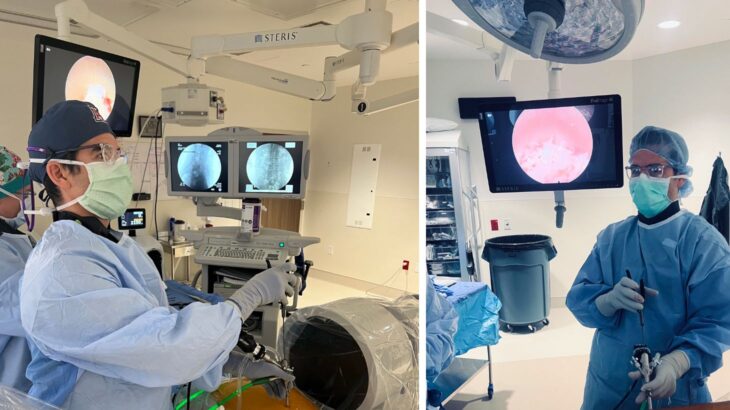
Endoscopic Spine Surgery: The Next Evolution in Minimally Invasive Spine Care
Minimally invasive spine surgery has transformed how surgeons approach spine conditions, offering patients smaller incisions and faster recovery times. Now, endoscopic spine surgery represents the latest advancement in this field, taking minimally invasive techniques to new levels of precision and patient comfort. Dr. Justin Ledesma, an orthopedic spine surgeon, explains how this innovative approach is changing the landscape of spine care.
What is Endoscopic Spine Surgery?
“Endoscopic spine surgery is the next step in making things more minimally invasive,” explains Dr. Ledesma. Using an incision about the size of a fingernail, surgeons can access the spine through a tiny camera similar to those used in knee arthroscopy. This advanced technique allows surgeons to directly visualize neural structures while performing various procedures that traditionally required larger incisions.
Key Benefits
The advantages of endoscopic spine surgery extend beyond just a smaller incision:
- Minimal Tissue Disruption: The technique often requires little to no bone removal and preserves supporting structures, reducing the risk of instability.
- Reduced Pain Medication: Approximately 90-95% of patients manage post-operative pain with just over-the-counter medications like Tylenol and ibuprofen, avoiding the need for narcotic pain medications.
- Faster Recovery: Many patients can begin increasing their activities after just two weeks, though specific recovery times are tailored to each patient’s situation and goals.
- Better Access: Some conditions, particularly foraminal disc herniations, can actually be easier to treat with endoscopic techniques compared to traditional approaches.
Ideal Candidates
Several spine conditions are well-suited for endoscopic surgery, with two common examples being:
- Disc Herniations: About 90% of disc herniations in the back are candidates for endoscopic treatment.
- Facet-Mediated Back Pain: For patients experiencing pain with activities like getting out of a chair or bending and twisting, endoscopic medial branch transection offers a potentially permanent solution. This procedure often provides an alternative to repeated radiofrequency ablations (RFAs).
Not all spine conditions are suitable for endoscopic treatment. Patients with major deformity, significant instability, or severe degenerative disc disease may be better candidates for traditional surgical approaches.
The Procedure
During endoscopic spine surgery, surgeons follow these key steps:
- Precise targeting using X-ray guidance
- Making a small incision about the width of a fingernail
- Inserting a series of dilators to create a working channel
- Placing an 8-millimeter cannula
- Introducing the camera with continuous irrigation for clear visualization
- Performing the necessary surgical procedure through specialized instruments
Looking to the Future
Endoscopic spine surgery is advancing quickly, and there are exciting possibilities ahead. While no one can predict the future, Dr. Ledesma envisions several potential developments where endoscopic spine surgery could continue to expand:
- New techniques using two small incisions instead of one, allowing for more complex procedures
- Minimally invasive options for spine fusion, which could provide relief for more types of back issues
- Smarter tools that use navigation technology and AI to guide the surgeon during surgery
- Predictive technology that could help identify the best candidates for surgery and improve outcomes
Making the Right Choice for You
“It’s another tool in the tool bag,” says Dr. Ledesma. While endoscopic spine surgery isn’t suitable for every patient, it offers many people an opportunity to avoid or delay more extensive procedures like spinal fusion. The key is matching the right procedure to each patient’s specific condition, goals, and lifestyle.
For many patients, especially older adults or those hoping to avoid major surgery, endoscopic spine surgery can provide significant relief while maintaining the option for more extensive procedures in the future if needed. The focus remains on achieving meaningful improvement in quality of life, whether that means returning to rock climbing or simply being able to play with grandchildren comfortably.
If you’re experiencing back pain or spine-related symptoms, schedule a consultation online with Dr. Ledesma or call at 303-233-1223 to learn if endoscopic spine surgery might be right for you.